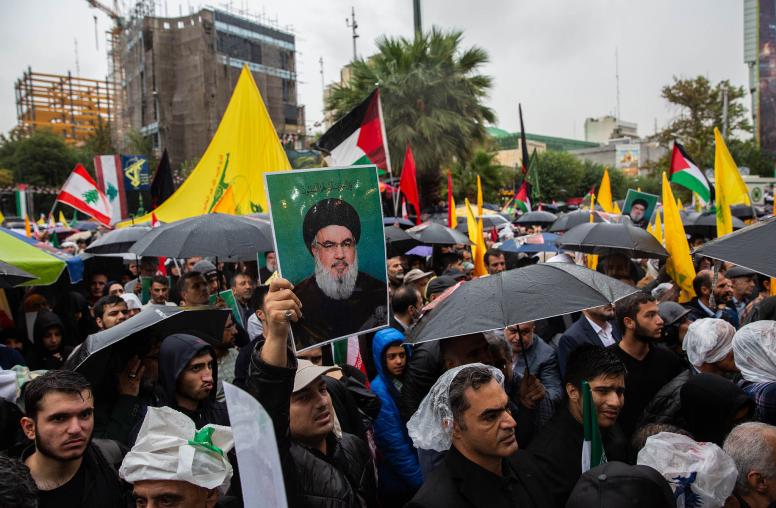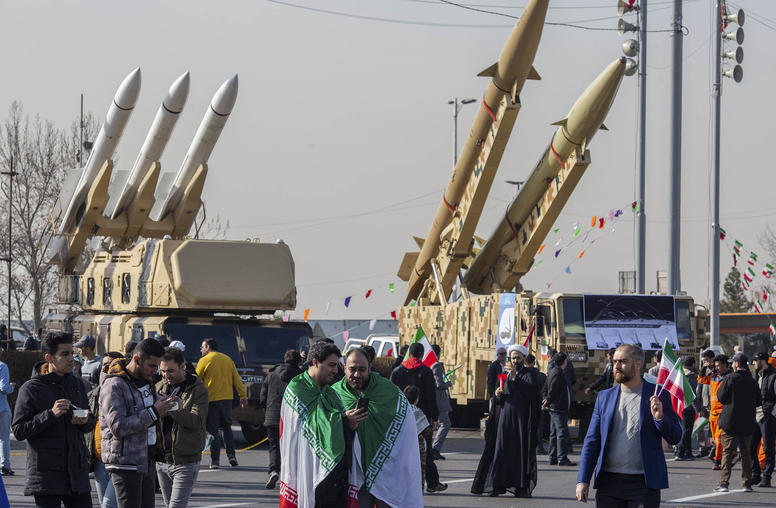Syria's Role in Lebanon
As the political situation in Lebanon grows increasingly volatile, the nature of Syria’s role in Lebanon and, in particular, its alliance with Hezbollah, warrants closer examination.
This is the third in a series of USIPeace Briefings on Syria. The first, "Syria and Political Change," was published in December 2005. The second, "Syria and Political Change II," was published in March 2006. The fourth "Syria's Relations with Iraq" was published in April 2007, and the fifth "Syria’s Alliance with Iran," was published in May 2007.
Recent days have witnessed increasing tensions between the United States and Hezbollah and its Syrian and Iranian backers. Citing "mounting evidence," the United States accused Hezbollah, Syria, and Iran of seeking to destabilize the current Lebanese government headed by Prime Minister Fuad Siniora. The White House also singled out the Syrian government for condemnation, stating there were "indications" that Damascus is attempting to obstruct the creation of an international tribunal to try those involved in the February 2005 assassination of former Lebanese Prime Minister Rafik Hariri. Syria has denied all accusations. As the political situation in Lebanon grows increasingly volatile, the nature of Syria's role in Lebanon and, in particular, its alliance with Hezbollah, warrants closer examination.
Main Points:
- Syria's interests in Lebanon are both complex and deeply entrenched. Despite the withdrawal of the Syrian military last spring, Syria's longstanding political, economic, and social ties constitute a vast network of influence within Lebanon.
- Nonetheless, the days of undiluted Syrian hegemony in Lebanon have ended. The Syrians can no longer dictate their desires to willing Lebanese proxies. Instead, they have been forced to employ a variety of tactics ranging from negotiation and persuasion with allies to intimidation and violence against political adversaries.
- Syria's alliance with Hezbollah has evolved significantly over the past two decades. While the Syrians have played a key role in transshipping arms from Iran to Hezbollah, their influence among the Shiite militia's senior decision-makers appears more limited. Damascus likely had little if any influence over the events that led to Hezbollah's war with Israel this past summer. At the same time, the Syrian regime has exploited Hezbollah leader Hassan Nasrallah's rising popularity to bolster its popular legitimacy.
- Two key political trends in both Syria and Lebanon—weakening state institutions and mounting "cronyism" and corruption—suggest that the situation will become increasingly volatile as key players in both countries struggle to assert their interests in an increasingly fluid situation.
An Intricate Web of Ties
Syria's geostrategic interests in Lebanon are longstanding. During the Ottoman era, Lebanon was part of Greater Syria. To date, the Syrian government steadfastly refuses to formally demarcate the border or agree to the establishment of diplomatic relations, claiming the two countries share an organic bond. Following the passage of UN Security Council Resolution 1701 which ended hostilities between Israel and Hezbollah, the Syrians refused to accept the deployment of foreign troops along the border, claiming it would be a "hostile" act against Syria. Lebanon has also served as a battleground for a number of proxy wars, including one between Syria and Israel. The Syrians have often used surrogates in Lebanon, in particular Hezbollah, in order to maintain pressure on Israel.
Furthermore, as Syria's "soft underbelly," Lebanon holds significant strategic value to Syria as a potential invasion route. Indeed, some observers speculate that Israel's return of the Golan Heights to Syria is a sine quo non for the Syrians to cease meddling in Lebanese affairs. In the meanwhile, Syrian hegemony over Lebanon was cemented following the 1989 Ta'if Accord which eventually ended the 15-year Lebanese civil war, and confirmed Syria's role as the primary powerbroker. The 1990s were marked by Syria's dominance of Lebanese affairs, bolstered by between 15,000 and 40,000 troops and a pervasive intelligence apparatus, with vast corruption networks enriching Syria's political elite.
Indeed, to fully understand Syria's role in Lebanon, it is essential to grasp how deeply enmeshed the two economies are. Both economies are characterized by sizeable informal sectors, by some estimates representing as much as 25 to 50 percent of GDP. It is in this informal realm that entrenched networks of patronage and corruption operate, linking the two countries through a complex web of informal business connections and family ties. In addition, a variety of statistics (e.g., labor, trade, and financial) attests to a mutual dependence that shows no sign of diminishing.
- Labor. Lebanon serves as an important outlet for surplus Syrian labor, with an estimated 300,000 permanent Syrian workers in Lebanon. The figure rises to one million when including seasonal laborers who come to Lebanon to work on construction projects and in the agricultural sector. Indeed, Syrian workers played a crucial role in Lebanon's post-civil war reconstruction, and new construction opportunities will likely arise following this summer's war with Israel. Aside from absorbing Syria's excess labor supply, economic opportunities in Lebanon inject the Syrian economy with an important source of earnings; worker remittances from Lebanon to Syria are estimated to be approximately $1 billion.
- Trade. For its part, Lebanon depends on Syria as a key transit point for its exports. In 2005, overland trade crossing the Lebanese-Syrian border was estimated between $600 and $700 million, with 35 percent of Lebanese exports depending on this route. In the service sector, many well-to-do Syrians receive high-quality health care in Lebanon, while lower-income Lebanese take advantage of Syria's subsidized health care for their needs.
- Financial. Due to a variety of factors, the financial sectors of both countries have become increasingly integrated. The Syrian business community has long relied on Lebanese banks as an important financial safe haven, providing a respite from taxes. Many among the Syrian elite are key shareholders in a number of Lebanese banks. Meanwhile, particularly following the imposition of U.S. economic sanctions, most banks that have recently opened in Syria are branches of Lebanese banks, providing Syrian businessmen the means to elude restrictions.
Diminished Syrian Hegemony
Despite these longstanding ties, Syrian dominance in Lebanon has diminished following its military withdrawal last year. At the same time, Hezbollah's relative power and independence have steadily increased beginning with the 2000 Israeli withdrawal from south Lebanon. Gone are the days of Syrian rule by virtual diktat. No longer buttressed by a substantial military presence on the ground, Damascus has been forced to resort to a variety of less coercive tactics to insure that its interests are preserved. Indeed, Syrian influence, while still significant, no longer completely dominates the Lebanese political scene.
Evolving Alliance with Hezbollah
Syria's alliance with Hezbollah has evolved significantly over time, reflecting the ebb and flow of Syria's projection of power into Lebanon more broadly. During the era of Syria's outright dominance in Lebanon in the nineties, Hezbollah acted very much as the "junior partner" in the strategic relationship. In those years, Damascus held significant sway over the Shiite militia. Nonetheless, it is important to note that Hezbollah's ties to its Iranian patrons were much deeper, based on a shared religious identity and ideology.
Beginning in 2000, with the Israeli withdrawal from Lebanon and the death of Syrian President Hafez Assad, Hezbollah gained greater standing in the alliance as its strength and influence increased within the Lebanese political arena and the new Syrian president struggled to gain his footing. Today, the alliance appears to be more akin to an equal partnership, with the Syrians seeking to exploit Hezbollah leader Hassan Nasrallah's burgeoning popularity on the Arab street to shore up domestic support.
Syrian ties to Hezbollah are best understood through the prism of Syria's strategic alliance with Iran. Mutual support for Hezbollah is one of the key elements that define Syrian-Iranian relations. Syria's role as a transshipment point for arms from Iran constitutes the critical element of its cooperation with Hezbollah. Damascus likely does not wield significant influence with regard to Hezbollah's strategic decision-making.
Cross-border Cronyism
"Crony capitalism"—an informal power system that derives significant benefits from corrupt practices such as bribery and smuggling—characterizes both Syria and Lebanon. Control over these activities by a network of power brokers has perpetuated the weakening of state institutions, contributing to a status quo that favors corruption and rent-seeking over the establishment of strong state institutions. Ironically, Hezbollah's ascendance in Lebanon marks the first occasion that an alternate center of power that is not vested in these corrupt networks has gained traction in Lebanon. A decision by Hezbollah to redirect its attention to internal Lebanese issues and focus on corruption could disrupt its alliance with Syria.
Meanwhile, the vast network of patronage and corruption that characterized Syria's role in Lebanon prior to its military withdrawal may be somewhat altered, but it will not disappear. This past summer's war has created more opportunities for corruption as new reconstruction efforts get under way. Cronyism on both sides of the border will continue to militate against the establishment of transparent democracies in either Syria or Lebanon. Indeed, shifts toward a stronger state in either country will necessarily endanger the informal "crony capitalism" that dominates the other, resulting in a powerful tendency to preserve the status quo on both sides.
Future Implications
Two key factors are reshaping Syria's role in Lebanon: the Syrian military withdrawal and the political ascendance of Hezbollah, its key ally. Taken together, these developments have redefined the relationship, placing Hezbollah on more equal footing with Syria and transforming the alliance into more of an equal partnership. Lacking forces on the ground, Syria will likely rely increasingly on Hezbollah to guarantee that Syrian interests are protected.
Despite these changes, certain constants--mutually dependent economies, strong family ties, and murky corruption networks enriching elites on both sides of the border--form the bedrock of the Syrian-Lebanese relationship. As Lebanon's internal situation grows more volatile, Syrian meddling likely will intensify as Damascus moves to insure that its interests are preserved in the ensuing political turmoil. The Syrians will likely work against the establishment of a strong, democratic government in Lebanon, which would threaten its vast networks of corruption and patronage. Ultimately, while the contours of Syria's role in Lebanon may be changing, its essence, borne of deeply entrenched political, economic, and social interests, remains the same.
This USIPeace Briefing was written by Mona Yacoubian, special adviser in the Center for Conflict Analysis and Prevention at the United States Institute of Peace. The views expressed here are not necessarily those of the Institute, which does not advocate specific policies.



